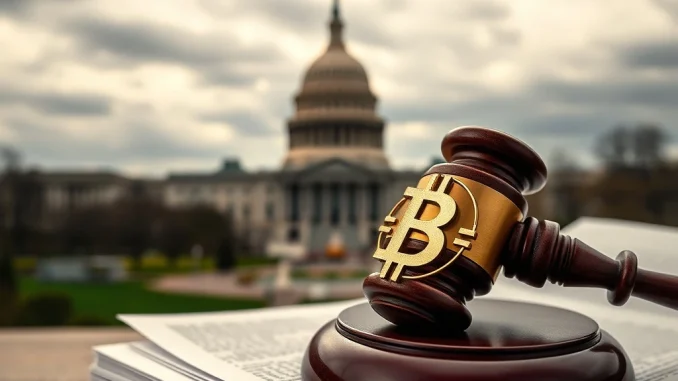
The world of digital assets is constantly evolving, and with that evolution comes the inevitable march of regulation. For anyone invested in the future of cryptocurrency, understanding the legislative landscape is not just important – it’s absolutely crucial. A significant moment is fast approaching as the U.S. House prepares for a pivotal vote on the GENIUS stablecoin bill, a development that could reshape how digital currencies are viewed and managed within the American financial system.
What is the GENIUS Stablecoin Bill and Why Does it Matter?
Stablecoins, digital currencies pegged to a stable asset like the U.S. dollar, have become a cornerstone of the crypto economy. They facilitate trading, provide liquidity, and offer a bridge between traditional finance and the decentralized world. However, their rapid growth has also raised questions about consumer protection, financial stability, and market integrity. This is where the GENIUS rule comes into play.
According to Eleanor Terrett, host of Crypto in America, the U.S. House is slated to hold a rule vote on the GENIUS stablecoin bill on July 18. While the specifics of the GENIUS bill haven’t been fully detailed in public reports, its primary objective is expected to be establishing a comprehensive regulatory framework for stablecoin issuers and operations. Such a framework aims to:
- Enhance Consumer Protection: By requiring stablecoin issuers to hold adequate reserves and undergo regular audits, ensuring that users can redeem their tokens for the underlying asset.
- Mitigate Financial Risks: Preventing potential runs on stablecoins that could destabilize broader financial markets.
- Foster Innovation with Clarity: Providing clear guidelines can encourage legitimate businesses to enter the stablecoin space, knowing the rules of engagement.
- Combat Illicit Activities: Implementing Anti-Money Laundering (AML) and Know Your Customer (KYC) provisions to prevent stablecoins from being used for illegal purposes.
The passage of a robust stablecoin bill is seen by many as a critical step towards mainstream adoption of digital assets, offering a degree of legitimacy and safety that some institutional investors currently demand.
CLARITY on the Horizon: What Does the CLARITY Bill Entail?
Beyond stablecoins, the broader landscape of crypto regulation is also on the congressional agenda. The CLARITY market structure bill, another piece of significant legislation, is also being closely watched. While its rule vote may be postponed until next week, its potential impact on how digital asset markets operate in the U.S. cannot be overstated.
The CLARITY bill is anticipated to address fundamental questions about the classification of digital assets – are they securities, commodities, or something else entirely? This distinction is crucial because it determines which regulatory body (e.g., SEC or CFTC) has jurisdiction. Key areas the CLARITY bill is expected to touch upon include:
- Market Definitions: Providing clear definitions for different types of digital assets and the services built around them (e.g., exchanges, custodians).
- Regulatory Authority: Assigning specific oversight responsibilities to relevant agencies, reducing regulatory arbitrage and uncertainty.
- Exchange Operations: Setting standards for how crypto exchanges operate, including listing requirements, trading rules, and investor protection measures.
- DeFi Considerations: Beginning to grapple with the unique challenges of decentralized finance, though this remains a complex area for traditional regulation.
The delay in the CLARITY bill’s vote suggests ongoing discussions and potential amendments, highlighting the complexity and the diverse perspectives within the US House regarding comprehensive digital asset legislation. Both the GENIUS and CLARITY bills represent a concerted effort by lawmakers to bring greater order and accountability to the burgeoning crypto industry.
The US House Legislative Calendar: Why July 18 is Key
The announcement that the US House will hold a rule vote on the GENIUS stablecoin bill on July 18 is a significant marker in the legislative calendar. A ‘rule vote’ is a procedural vote that sets the terms for debate on a bill, including how much time will be allotted for discussion and which amendments, if any, will be considered. It’s a critical step before a final floor vote on the bill itself.
For the crypto community, this date signifies that lawmakers are serious about moving forward with digital asset legislation. While the initial reporting focuses on the rule vote, it paves the way for the full House to consider the bill shortly thereafter. The legislative process is often slow and fraught with political complexities, making this scheduled vote a notable acceleration in the efforts to regulate stablecoins.
Historically, Congress has grappled with how to approach crypto. Early attempts were often fragmented, but recent years have seen more coordinated efforts to develop a holistic framework. The bipartisan nature of some of these discussions suggests a growing recognition of crypto’s permanence and importance. The upcoming votes are a testament to this evolving understanding and the increasing pressure from various stakeholders to provide regulatory clarity.
Anti-CBDC Provisions: A Stand on Digital Currency and Privacy
Adding another layer to the legislative narrative, Eleanor Terrett also highlighted that anti–Central Bank Digital Currency (CBDC) provisions are expected to be included in the National Defense Authorization Act (NDAA). This development is distinct from the stablecoin and market structure bills but equally impactful for the future of digital currency in the U.S.
A CBDC is a digital form of a country’s fiat currency, issued and backed by its central bank. While proponents argue CBDCs could improve financial inclusion, payment efficiency, and monetary policy control, critics raise significant concerns, primarily centered around:
- Privacy: Fears that a CBDC could give the government unprecedented surveillance capabilities over citizens’ financial transactions.
- Centralization: Concerns about the potential for a CBDC to concentrate power in the hands of the central bank, potentially disintermediating commercial banks.
- Government Control: Worries that a CBDC could be used to implement negative interest rates or even ‘programmable money’ with expiry dates or spending restrictions.
The inclusion of anti-CBDC provisions in the NDAA, a critical annual defense spending bill, underscores the bipartisan opposition to a U.S. CBDC among a significant segment of lawmakers. This move signals a strong preference for private sector innovation in digital assets, particularly stablecoins, over a government-issued digital dollar. It reinforces the idea that the U.S. intends to foster a private, competitive market for digital currencies, rather than developing a centralized, state-controlled alternative.
Navigating the Future of Crypto Regulation: What Comes Next?
As these legislative efforts unfold, what does it mean for the average crypto enthusiast, investor, or business? The immediate future promises continued debate and potential shifts in the regulatory landscape. Here are some actionable insights and what to watch for:
- Stay Informed: Follow reputable crypto news sources and legislative updates closely. The details of these bills can significantly impact various aspects of the crypto ecosystem.
- Understand the Nuances: Differentiate between different types of digital assets and the regulations that might apply to them. A stablecoin bill affects stablecoins, while market structure bills impact exchanges and broader asset classifications.
- Prepare for Change: For businesses operating in the crypto space, proactive engagement with legal counsel to understand potential compliance requirements will be crucial.
- Advocate for Your Interests: Where possible, engage with advocacy groups or directly with lawmakers to express your views on proposed legislation. Public input can influence policy.
- Observe Global Trends: While U.S. regulation is critical, global regulatory developments in regions like the EU (MiCA) and Asia also provide insights into the future direction of crypto governance.
The upcoming votes are not just procedural; they are indicative of a maturing industry facing its moment of truth in the halls of power. The outcome will shape investment decisions, technological development, and the overall trajectory of digital assets for years to come.
The legislative efforts in the U.S. House, particularly concerning the GENIUS rule and the CLARITY bill, mark a watershed moment for the cryptocurrency industry. These developments signify a concerted push towards establishing clear regulatory frameworks for stablecoins and the broader digital asset market. Coupled with strong anti-CBDC sentiment, the U.S. appears to be charting a course that favors private innovation within a regulated environment. As July 18 approaches and discussions around the CLARITY bill continue, the crypto community must remain vigilant, informed, and prepared for the profound changes these legislative actions could bring.
Frequently Asked Questions (FAQs)
Q1: What is a “rule vote” in the U.S. House?
A rule vote is a procedural vote that establishes the terms for debating a bill on the House floor. It determines how much time will be allotted for discussion, which amendments can be offered, and other procedural aspects before the final vote on the bill itself.
Q2: How will the GENIUS stablecoin bill impact everyday crypto users?
If passed, the GENIUS stablecoin bill aims to bring greater stability and consumer protection to stablecoins. This could mean more transparency regarding reserves, potentially safer stablecoin options, and increased confidence in using them for transactions and trading. It might also lead to clearer guidelines for crypto exchanges that list stablecoins.
Q3: What are the main differences between the GENIUS stablecoin bill and the CLARITY market structure bill?
The GENIUS stablecoin bill specifically targets the regulation of stablecoins, focusing on issues like reserve requirements and issuance rules. The CLARITY market structure bill, on the other hand, aims to provide a broader framework for classifying digital assets (e.g., as securities or commodities) and regulating the overall crypto market infrastructure, including exchanges and trading platforms.
Q4: Why are anti-CBDC provisions being included in the National Defense Authorization Act (NDAA)?
The inclusion of anti-CBDC provisions in the NDAA reflects a strong bipartisan concern among some lawmakers about the potential implications of a U.S. Central Bank Digital Currency (CBDC) for privacy, government control over finance, and the role of private banking. Attaching it to a must-pass bill like the NDAA is a strategic move to ensure these concerns are addressed in legislation.
Q5: What should crypto investors do to prepare for these potential regulatory changes?
Investors should stay informed by following reliable news sources, understand the potential impact of new regulations on different types of digital assets, and consider diversifying their portfolios. For those involved in crypto businesses, consulting with legal experts to ensure compliance with upcoming regulations will be essential.



